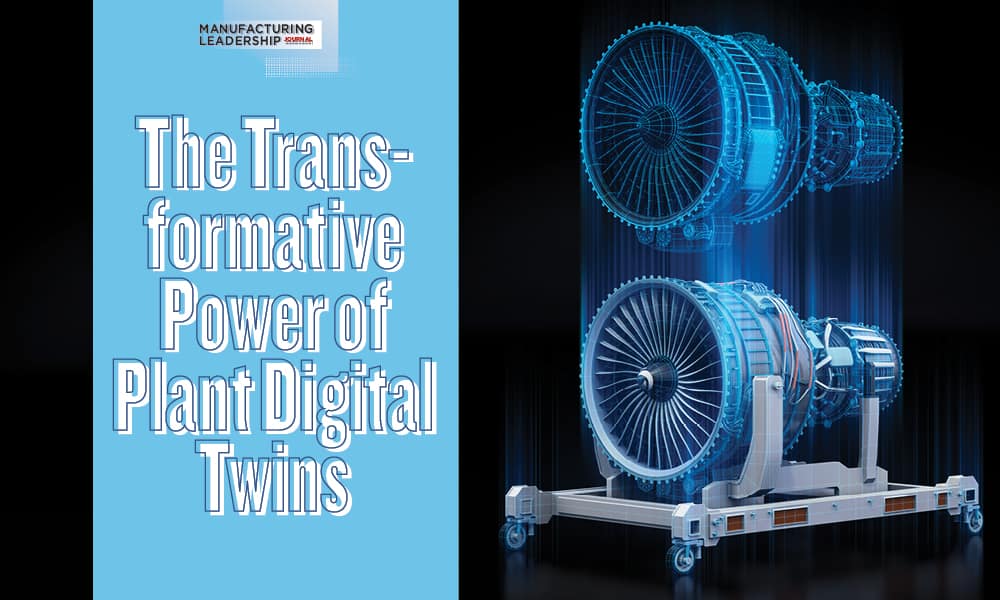
Manufacturing has become the shock absorber for much of the disruption that companies have faced during the pandemic. Agility in planning and scheduling the factory has never been more important and yet has never been more difficult.
By Matt A. Brown and Jim Ashby

In a recent Ernst & Young LLP survey of 500 senior-level executives from companies across the Americas with more than $1 billion in revenue, 53% of respondents said that fast-changing consumer preferences require supply chains that can turn on a dime.1 The ability for supply chains to respond in real time was consistently identified as a key capability that is needed by respondents across industries. But it’s increasingly apparent that traditional supply chain planning systems, conceived in simpler, less volatile times, have underperformed in the current environment, leaving professionals seeking a better solution.
As a virtual replica of a physical product, piece of production equipment, or supply chain, a digital twin has been viewed as a potential solution to these ongoing issues. A digital twin provides a testing ground for monitoring, simulating, and optimizing production, quality, and operational performance. In our experience, we have seen tremendous benefits using a plant digital twin across sectors, including manufacturing.2 (See figure 1)
In a manufacturing plant setting, the distinguishing characteristics of a plant digital twin are its ability to model complex system dynamics and decision logic, as well as the use of near real-time data to maintain an ongoing understanding of the current state of the plant, virtually. The acid test for a plant digital twin is its capability to capture the dynamically changing constraints on the shop floor, so that management can sense the necessary rate of change for the business model and respond with a feasible plan.
There are eight key benefits to a plant digital twin:
1 Ability to answer highly strategic questions
Using a plant digital twin, you can model the system dynamics and manufacturing complexity needed to answer significant questions that will determine the future. They give you insights into questions such as:
- How are we going to answer our customers’ requests for more variety and shorter lead times?
- How can I ensure that my capital allocation decisions will generate the highest returns for the company?
- How can I be sure that our product-to-plant allocations are cost-efficient?
- How will my manufacturing footprint need to change given how we expect the product portfolio and customer base to evolve for 2030, and how will that impact our capital allocation planning?
Plant digital twins can model these scenarios to help management evaluate trade-offs and consider second-order effects (each consequence has another consequence) that planning systems and spreadsheets are simply incapable of considering quickly. These digital twins can also incorporate cost and profitability aspects, which provide a robust financial analysis for a set of alternative options. The digital twin provides the critical lens needed for executives to make decisions: the operational key performance indicators and the impact to the financials.
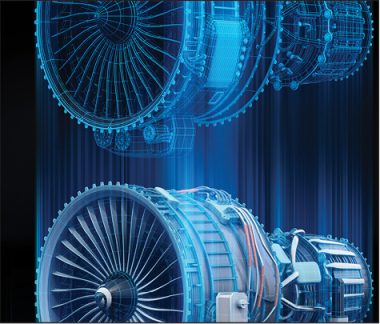
Digital twins can be deployed to evaluate the design of greenfield operations or additions to existing facilities before allocating capital.
Traditional modeling approaches involved running deterministic spreadsheet simulations or solvers whenever the business was confronted with a key decision. This was an analytical chore and resulted in a limited number of scenarios that were quickly outdated.
Leading plant digital twin solutions can run scenarios in seconds, by using high-speed memory databases and by leveraging highly connected data architectures that pull information from shop floor, enterprise resource planning (ERP), and Internet of Things (IoT) sources. As a result, plant digital twins become a strategic capability that allows executives to not only improve risk management through simulating worst-case scenarios but also test contingency plans.
2 Diagnoses and solutions for complex systems
Another key differentiator between a plant digital twin and a traditional scheduling system is the ability to diagnose problems within complex and dynamic systems. A plant digital twin models the structural complexity of processes, multlevel bills-of-materials, key constraints, product shelf life, labor skill levels, and complicated decision rules, but just as importantly, it captures and simulates the stochastic nature of the shop floor.
Here’s what we mean by stochastic nature: Consider a machine breakdown. We know the breakdown will occur, but we just don’t know when or for how long. A plant digital twin incorporates the probability of failures across all machines in the process, while traditional planning systems choose to ignore the “Murphy’s Law” of inevitability. The current plant digital twin technology can simulate a wide range of reliability and yield curves. Probability distributions are available for modeling demand fluctuations, allowing the model to predict failure points and potential bottlenecks.
The theory of constraints (TOC) puts much-needed focus on addressing bottlenecked work centers. Debottlenecking operations was once thought to be a relatively straightforward exercise, focused on identifying the bottleneck and removing the constraint. Then, rinse and repeat.
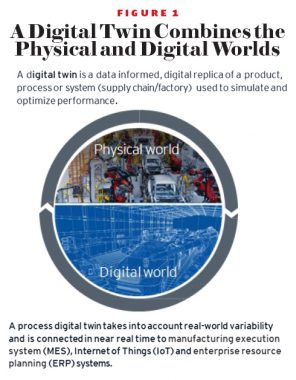
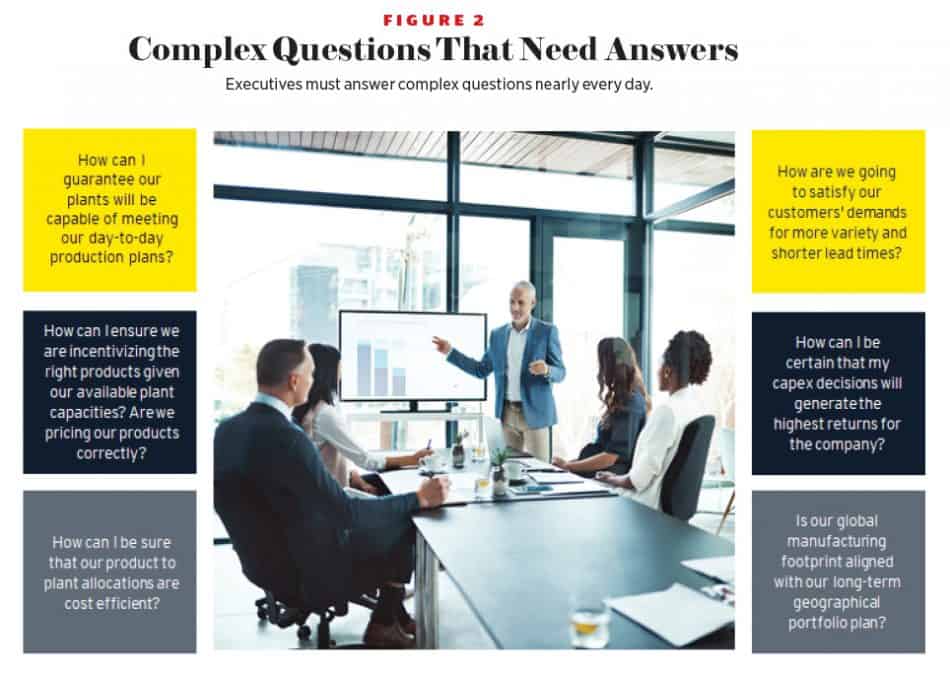
Our experience, however, is that bottlenecks will shift as the production mix or system dynamics change. With today’s dynamic systems, the bottleneck is constantly moving around the factory due to its multivariate nature. When using a plant digital twin, users can assess constraints across materials, resources, labor, and time to diagnose the current bottleneck.
Since the digital twin is a virtual replica of a system, solutions to current bottlenecks can be tested in a risk-free environment. And since the digital twin simulates the shop floor, second-order effects will be identified, which ensures that companies are not playing whack-a-mole or give-it-your-best guess on issues.
For greenfield operations or significant capital investments to existing manufacturing footprints, digital twins can be deployed to evaluate the design before allocating capital. Digital twins can increase efficiency of these new investments by 20% to 30% through simulating the new factory in the virtual environment. The nature of the environment promotes the principle of creativity before capital, as manufacturing personnel and leaders can design solutions within the model first. We recently worked with a leading OEM supplier, and our process digital twin was able to increase throughput of a new line by 40%, saving $750,000 per month through debottlenecking the design virtually.
3 Agile production scheduling
Because plant digital twins are connected to real-time data, reflect the stochastic nature of the actual shop floor, and model complex system dynamics, they offer tremendous value in plant production scheduling. Embedding the advanced scheduling algorithms into a plant digital twin can generate feasible schedules at scale and speed, boosting throughput 5% to 10% while significantly reducing cost. In high-speed manufacturing environments, clients with digital twins are rescheduling multiple times per day.
Normally, traditional planning systems generate the schedule on a weekly basis, which causes a natural and recurring dissonance between the schedule and the current state of operations. Schedulers and planners typically deal with this dissonance through spreadsheet jockeying, which does not capture the dynamics of the shop floor and can result in errors and omissions in the plan. More importantly, the schedulers and planners do not have a tool that enables scenario planning, which is a leading practice for evaluating trade-offs and outcomes, while maintaining operating policies and scheduling rules.
A plant digital twin production scheduling application is connected to the shop floor manufacturing execution system (MES), ERP system, and planning systems, which allow it to sense and respond to machine downtime events, poor yields, and changes in product mix. The digital twin will schedule around downtime of machines, which gives schedulers and planners a key tool in agile production scheduling. The digital twin’s connectivity is bidirectional, which allows it to send task lists to the shop floor as part of the overall schedule.
For example, the plant digital twin’s algorithm will determine the best sequence of changeovers for machines, labor schedule/shift requirements, and material arrival times at corresponding operations. The digital twin will also inform the supply chain planning system and ERP of the expected order completion dates. The digital twin becomes the cerebral cortex of the shop floor, planning and orchestrating all interconnected processes.
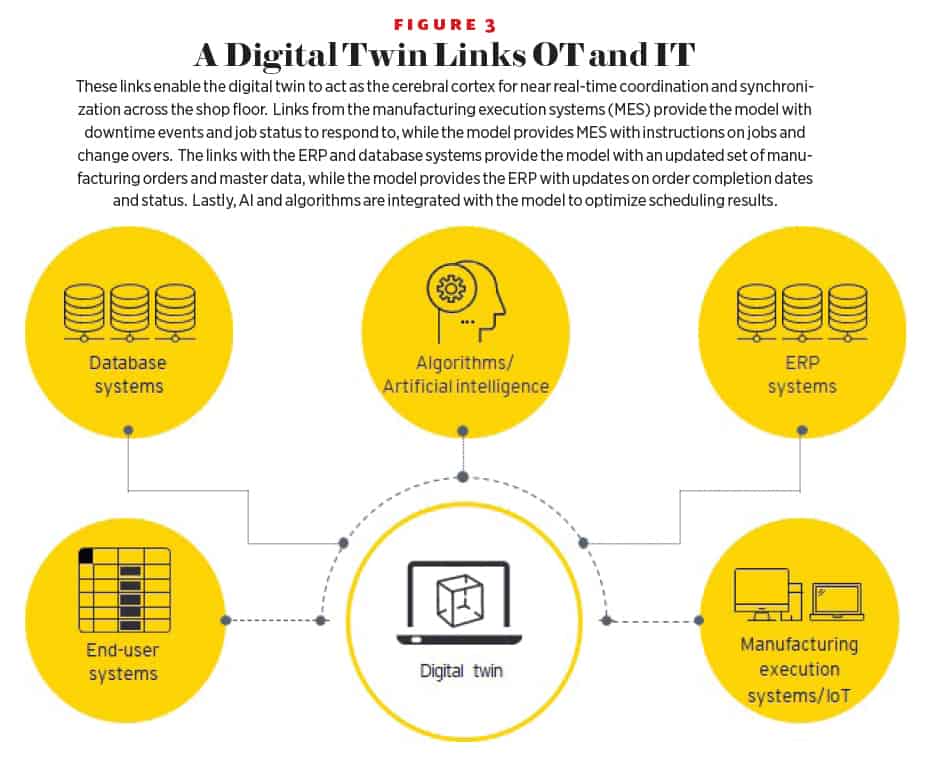
4 Autonomous decision-making
Given current challenges, increased decision speed is important for planners but with additional complexity, disparate IT systems, and outdated planning technology, making the right decision with consistency is difficult.3 A leading practice in planning and scheduling is exception-based planning, which enables planners to focus on the vital few exceptions that make the most impact to operations and the supply chain.4 However, without enabling technology, planners cannot find the time required to analyze data at high speed.
The latest digital twin solutions create a production schedule incorporating decision rules, evaluation criteria, and key performance indicators, which are coupled with the latest system data to generate a set of prescriptive actions for planners to ensure the right decision is made. In our experience, the behavioral change for planners can be difficult, as they have become accustomed to planning the minutiae, making it difficult to break the old firefighting behaviors and trust the system’s recommendations.5 A successful digital twin deployment requires a systematic change management approach to scientifically analyze results and prove the validity of the digital twin.
5 War games and simulations
The recent COVID-19 pandemic clearly illustrated the power of scenario planning, as companies that prepared and adjusted for the crisis were much more successful in taking advantage of market opportunities and in navigating the storm.6 Leading firms are now in a constant state of war-gaming, running a playbook of scenarios against the current and future projections. Proactively bringing these scenarios to management is a competitive advantage. Unfortunately, we’ve worked with many clients that did not have this capability and were significantly impacted financially as a result.
Developing a mechanism to run these scenarios continually is a key capability for many planning organizations. Eliminating non-value-added activities for planners and schedulers through autonomous planning, improvement in systems integration, and reduction of manual analysis can provide planners and schedulers with needed time to run simulations based on a risk analysis of the current environment and anticipated trends.
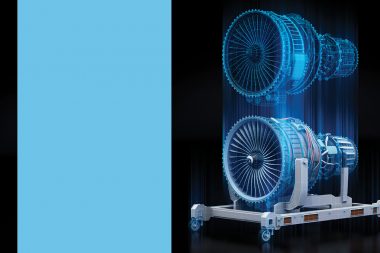
Plant digital twins can model various scenarios to help management evaluate trade0offs and consider second-order effects.
Plant digital twins run scenarios based on mix, alternate routings, crew schedules, projected interruptions in supply, and interruptions due to machine downtime. Leading plant digital twin solutions can run experiments with statistically significant replications to provide the company with a high level of confidence in the results. Integrating this capability into a scenario planning process will result in a robust capability to plan and prepare for the next disruption.
6 A single, more accurate source of truth on capacity
Classic Association for Operations Management methodology utilizes levels of capacity planning within the organization that range from long-term (resource planning) to short-term (finite). For each level, there are different techniques (i.e., capacity planning using overall factors, capacity bills or resource profiles7) used to establish the capacity factors, which drive the estimated capacity that do not account for current inventory levels, use factors that are aggregated average of averages, and overall yield different results from the short-term finite schedules. In our experience, the aggregated, longer-term capacity analyses overstate capacity by 10% to 20% due to simplifying planning assumptions.
Lastly, a fundamental issue with these traditional capacity planning tools is rooted in the deterministic nature of the underlying model, which assumes no randomness. In complex manufacturing environments, choosing to ignore the variable and dynamic behavior on the shop floor will create inaccurate capacity plans. A common conflict arising on stated capacity levels occurs between the corporate entity supply chain personnel, who are using a generalized capacity model, and the plant personnel, who understand the true capacity but have difficulty substantiating it empirically with traditional planning tools. In many organizations, this translates to capacity estimates that cannot be reconciled between the levels or time spans.
Plant digital twins can be used across all time spans and levels of aggregation to satisfy short-, medium-, or long-term views of capacity. Since digital twins are driven by stochastic simulation models, the randomness and variability of the shop floor are factored into the capacity calculation. The result is a more accurate single source of truth on capacity and a lot less conflict between corporate and the plants.

The recent COVID-19 pandemic clearly illustrates the power of
scenario planning. Companies that were prepared were better at navigating the storm.
7 Improved capital allocation decisions
Because plant digital twins can measure capacity across time periods, perform activity-based costing, and rapidly model operations, companies can leverage them to improve their decision-making process for allocating capital.
The software we use for digital twins is object-oriented, which means that we can leverage existing modeling objects to build a new greenfield plant quite easily. During capital decision-making processes, we can quickly model different options across various scenarios to help determine the best allocation of capital. Since the digital twin can model flow, resources, labor and all of the constraints on the shop floor, these models identify potential risks and issues across the scenarios.
In a recent survey, 28% of manufacturing companies stated that they were “extremely likely” to bring production and sourcing back to America, as a method of de-risking the supply chain by moving suppliers closer to the final customer market.8 These investments are bold and significant. Ensuring that these moves will accomplish the expected returns can be achieved through solutions like digital twins to pressure-test potential choices.
8 ROI on Industry 4.0 investments
Integrating in real time with systems across the plant and enterprise, digital twins act as a cerebral cortex of the plant, synchronizing processes, labor, and flow, thereby maximizing your return on Industry 4.0 investments
The best digital twins have an open systems architecture, allowing it to be highly connected to systems and data, thereby monetizing current IT investments. The ability to schedule the facility requires connectivity to the MES and ERP systems. Typical data that interfaces between the ERP and the digital twin includes bills of materials (BOMs), routings, demand, and resources.
The MES provides the digital twin with the status of equipment and jobs on the shop floor, allowing for automated rescheduling around downtime. IoT tracking devices enable real-time inventory status, which can be interfaced to the digital twin as well. The digital twin will take all these Industry 4.0 investments to schedule and sequence the entire plant, including orchestrating all operations — through sending dispatch lists to machines that inform operators of when to change over, when materials are needed, and when preventive maintenance should occur. The digital twin is able to leverage all of these investments to achieve significantly higher throughput at lower cost.
Across many facets of your operations, these virtual environments make hidden opportunities visible to drive real-world results, acting as laboratories to reimagine what you do and how you do it — with speed, agility, and resilience. As transformative technologies like digital twins continue to rise to the forefront, how will your factory transformation strategy reinvent your future? M
De-risking Digital Twin Investments
In 2019, $1.3 trillion was spent on digital pilots across all industries, with $900 billion wasted on pilots that were not implemented 9. To de-risk your project, we recommend the following three areas of focus:
1. Project Definition & Feasibility Assessment: Every digital twin project should embed a preliminary assessment and specification phase entailing three steps. They are: development of a detailed specification of the model; assessment of data and systems feasibility to support the envisioned model; and assessment of the value, benefits, and return on investment for the specific digital twin uses cases. New technology holds promise and possibility of improvement for companies, which can result in firms embarking on digital journeys without due diligence. Following this assessment, it is not uncommon for companies to delay a project due to the lack of adequate systems and data to support the digital twin.
2. Agile Development: development of the model should follow an agile methodology. Frequent, short sprints or development cycles increase feedback cycles with users to help validate the digital twin. Incorporating data integration and validation tasks into each sprint will ensure that data issues are addressed earlier in the project.
3. Change Management Focused on End-User Adoption: Likely the most overlooked and underinvested area to de-risk a digital project is change management. From project kickoff through implementation, the impact on employees must be a strong area of focus. Digital twins can be viewed as a black box if not trusted or clearly understood by end users. A fundamental choice in ensuring transparency and trust of a digital twin’s logic and outputs is the selection of a solution vendor. Further, user adoption involves establishing this trust through validation of model recommendations throughout the development cycle.
FOOTNOTES
1. Steinberg, Glenn A. “How reinventing the supply chain can lead to an autonomous future.”, EY, 14 June 2019, www.ey.com/en_gl/advisory/how-reinventing-the-supply-chain-can-lead-to-an-autonomous-future.
2. Dharmani, Sven and Sachin, Lulla. “How digital twins give automotive companies a real-world advantage.” EY, 24 February 2020, https://www.ey.com/en_gl/advanced-manufacturing/how-digital-twins-give-automotive-companies-a-real-world-advantage.
3. Jolyon Austin and Matthew Brown. “How Reinventing the Supply Chain Can Transform the Planner Role.” EY, Kinaxis, 16 July 2020, www.kinaxis.com.
4. Global, EY. “Five steps to help you upgrade your supply planning.” 31 May 2019, https://www.ey.com/en_uk/consulting/five-steps-to-help-you-upgrade-your-supply-chain-planning.
5. Welsh, Jay, et al. “Can you switch on ‘lights-out’ planning to unlock value?,” 2018, https://www.ey.com/Publication/vwLUAssets/EY-can-you-switch-on-lights-out-planning-to-unlock-value/%24File/EY-can-you-switch-on-lights-out-planning-to-unlock-value.pdf.
6. Steinberg, Glenn. “COVID-19: How to protect your supply chain,” EY, 18 March 2020, https://www.ey.com/en_gl/consulting/how-to-build-a-supply-chain-thats-resilient-to-global-disruption.
7. Jacobs, F. Robert. “Manufacturing Planning and Control for Supply Chain Management: The CPIM Reference, Second Edition” (p. 301). McGraw-Hill Education. Kindle Edition, 23 July 2018.
8. Leonard, M. (14 May 2020). 64% of manufacturers say reshoring is likely following pandemic: Survey. Retrieved August 01, 2020, from https://www.supplychaindive.com/news/manufacturing-reshoring-pandemic-thomas/577971/
9 Harvard Business Review – Digital Transformation Is Not About Technology